- drach09's home page
- Posts
- 2022
- 2020
- June (1)
- 2019
- 2018
- 2017
- 2016
- 2015
- 2014
- December (13)
- November (2)
- October (5)
- September (2)
- August (8)
- July (9)
- June (7)
- May (5)
- April (4)
- March (4)
- February (1)
- January (2)
- 2013
- December (2)
- November (8)
- October (5)
- September (12)
- August (5)
- July (2)
- June (3)
- May (4)
- April (8)
- March (10)
- February (9)
- January (11)
- 2012
- 2011
- October (1)
- My blog
- Post new blog entry
- All blogs
Run-11 Transverse Jets: Trigger Definitions Revisited
The largest (but not only) hurdle between preliminary and final Run-11 results is understanding the behavior of the trigger definitions. As a reminder, for Run-11 data the trigger thresholds are the following:
| Trigger Level | DSM Threshold | Conversion Threshold |
| JP0 | 32 | 6.4 GeV |
| JP1 | 43 | 9.0 GeV |
| JP2*L2JetHigh | 64 | 13.9 GeV |
The standard definitions are as follows:
- Define a "floor" based on the hardware trigger
- If VPDMB "did fire" -- floor = VPDMB
- If JP0 "did fire" -- floor = JP0
- If JP1 "did fire" -- floor = JP1
- If JP2 "did fire" -- floor = JP2
- If AJP "did fire" -- floor = JP0
- Define as JP2 trigger if
- JP2 is more or equally restrictive to the floor
- JP2 or AJP "should fire"
- Jet pT > 16.3 GeV/c
- Jet matches to JP2 or AJP trigger patch
- Define as JP1 trigger if
- Conditions for JP2 not met
- JP1 is more or equally restrictive to the floor
- JP1 "should fire"
- Jet pT > 9.9 GeV/c
- Jet matches to JP1 trigger patch
- Define as JP0 trigger if
- Conditions for JP1 and JP2 not met
- JP0 is more or equally restrictive to the floor
- JP0 "should fire"
- Jet pT > 7.1 GeV/c
- Jet matches to JP0 trigger patch
- Define as VPDMB trigger if
- Conditions for JP0, JP1, and JP2 not met
- VPDMB is more or equally restrictive to the floor
- VPDMB "did fire" (no trigger simulator for VPDMB)
- Jet pT > 5.0 GeV/c
If there are errors in the trigger logic, my eyes are immune to them, at this point. As a first try at learning something new, I compare the raw pT spectra for the above standard definitions to the same definitions but removing the pT requirements. The study is performed for a single run, namely 12098021.
Figure 1
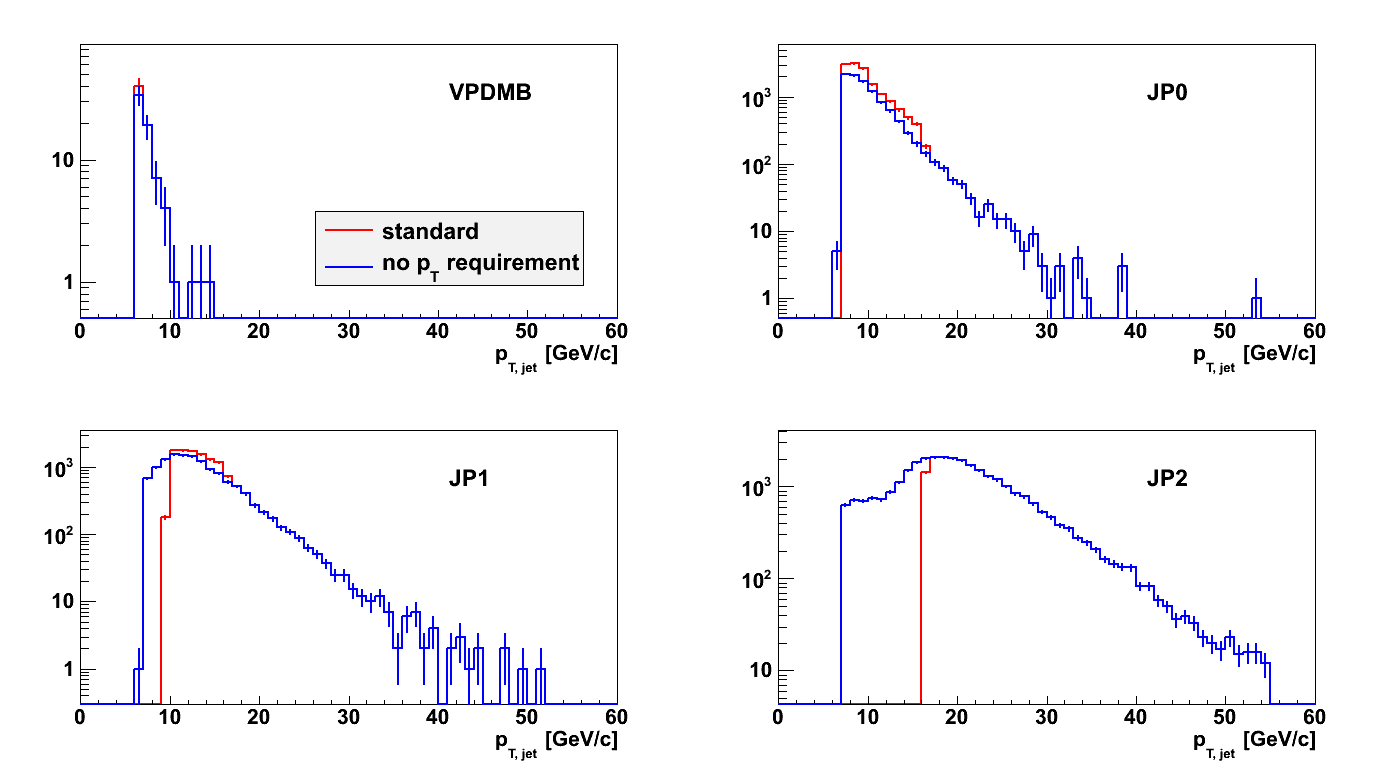
In Fig. 1 I show the comparisons for the standard and modified definitions for run 12098021. One can easily see the cut-offs from the pT restrictions in red. One can also see in blue the yield which falls below the pT restrictions but still satisfies the hardware, simulated, and geometric triggers. A considerable yield remains in JP2, tapering off toward less restrictive triggers. This phenomena appears to account for the hard fall-offs in the JP0 and JP1 spectra. The behavior of JP0 and JP1 in the modified definitions appears to be not completely crazy. The JP2 behavior, however, appears to be quite strange. Upon further inspection, it also seems somewhat strange that there is so much JP1 yield below the nominal trigger threshold of 9 GeV. Since the hardware trigger is implemented through the floor restriction in both versions, it seems odd that the yields would extend so far below the thresholds. It seems suggestive that perhaps there is an issue with my application of AJP, which gets a floor set at JP0. It is perhaps inforative to rerun, isolating the contributions of JP2 and AJP.
Figure 2
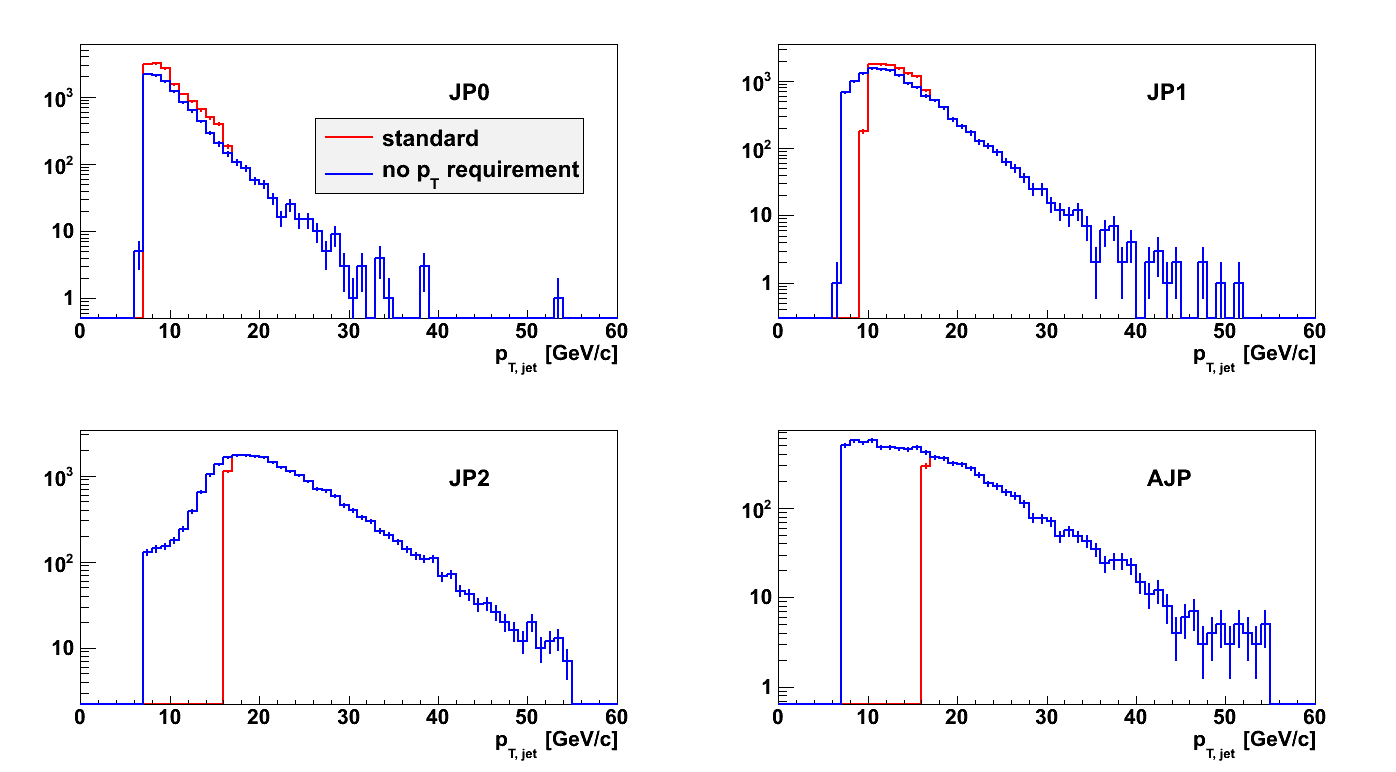
In Fig. 2 I show the result of separating AJP and JP2. In the trigger assignment, now, I check the requirements for AJP, first, then JP2, and follow the standard procedure from there. It is quite clear that AJP has an issue. There is no sign at all of a trigger turn-on in AJP. JP2 still seems to have an issue, as well, though the problem is not as bad removing AJP.
Figure 3
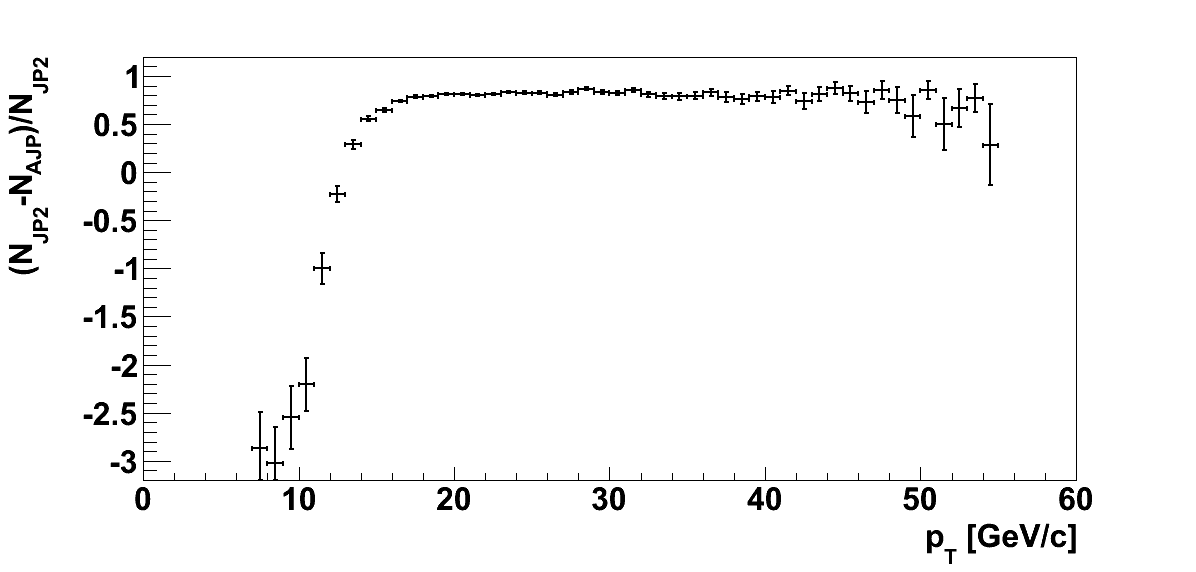
AJP was intended to merge well with JP2, thus, it may be informative to compare AJP behavior directly to that of JP2. In Fig. 3, I show the ratio of AJP to JP2. Above 17 GeV/c the behavior is quite flat, a constant fit yields 0.814±0.00356 with χ2/ν = 39.07/37. Thus, in the region above my standard pT cut, the behavior of AJP and JP2 is quite consistent.
Flipping AJP and JP2
As another check, Adam suggested flipping the order of AJP and JP2, i.e. testing for JP2 before testing for AJP, as well as comparing the raw spectra for leading AJP jets to all AJP jets.
Figure 4
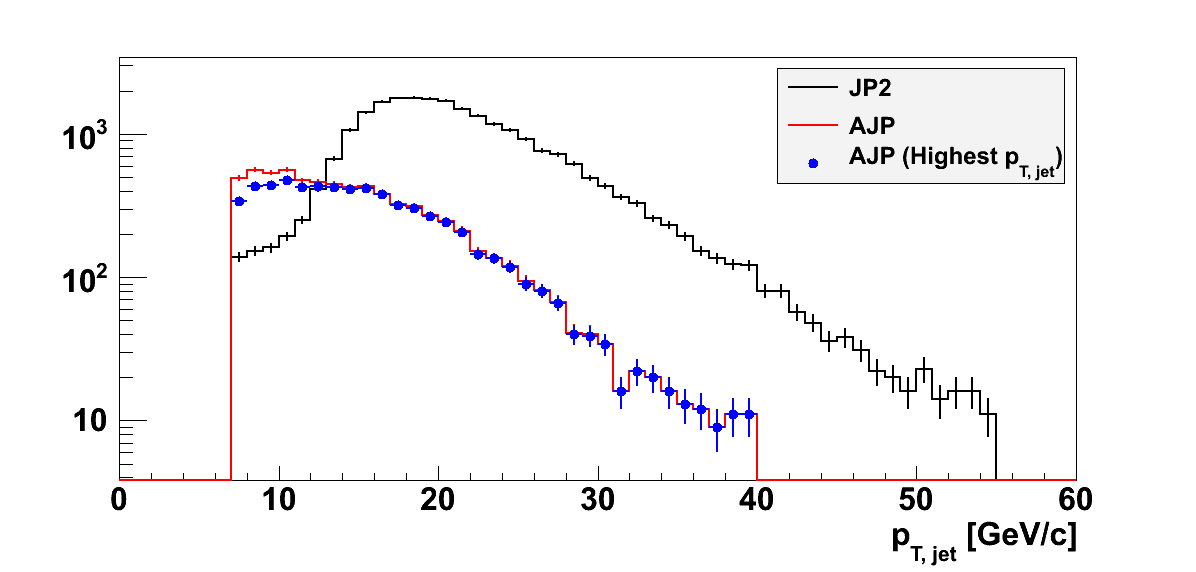
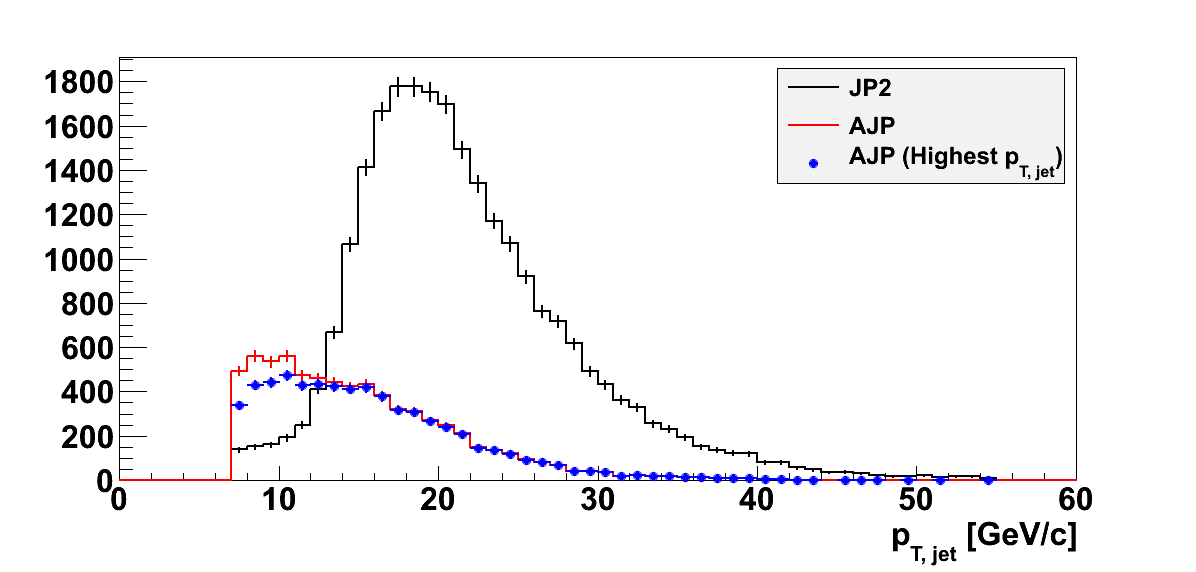
In Fig. 4, I compare JP2, AJP, and leading AJP, having flipped the order of the AJP and JP2 tests, for log(y) and lin(y). There appears to be a slight bump in AJP around 16 GeV/c when viewing the spectra in linear scale. Also, it appears that some of the low-pT AJP yield is from secondary jets. This should not be terribly surprising, and it does not appear the higher multiplicity is enough to account for a lack of a strong "turn-on" of the AJP trigger. Anselm's suggestion of looking at the spectra for a larger radius might be similarly informative, as the larger radius should have fewer split jets.
Figure 5
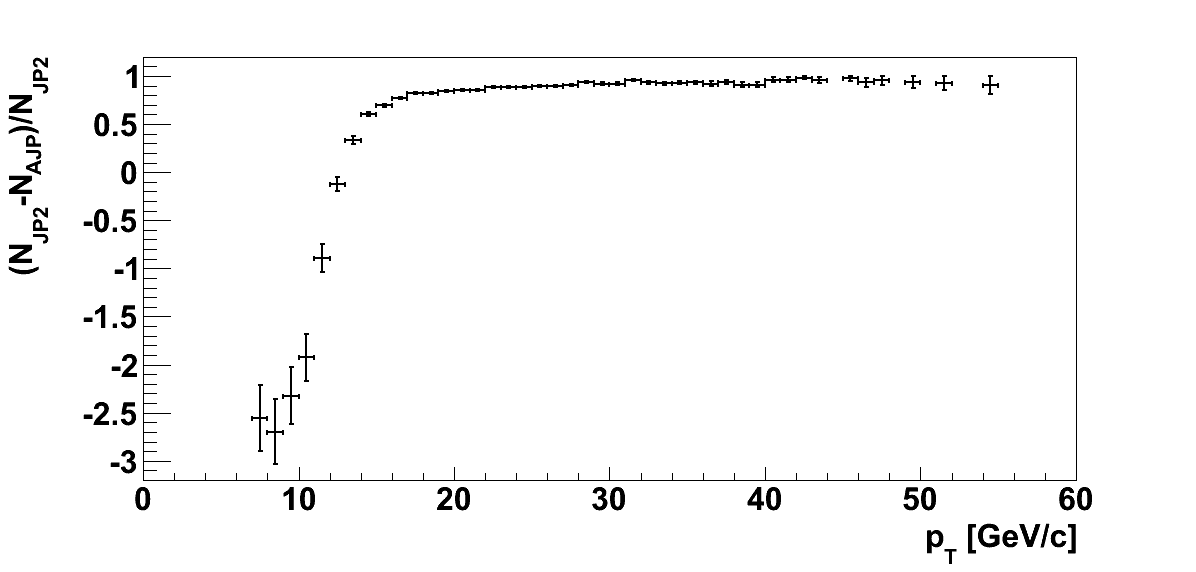
Flipping the order of AJP and JP2 slightly alters the behavior of the ratio. By 27 GeV/c, the ratio of AJP to JP2 is entirely flat. From 20 GeV to 60 GeV, the ratio is quite linear with a slope of 0.0044±0.00043/GeV/c with χ2/ν = 34.88/28.
- drach09's blog
- Login or register to post comments
